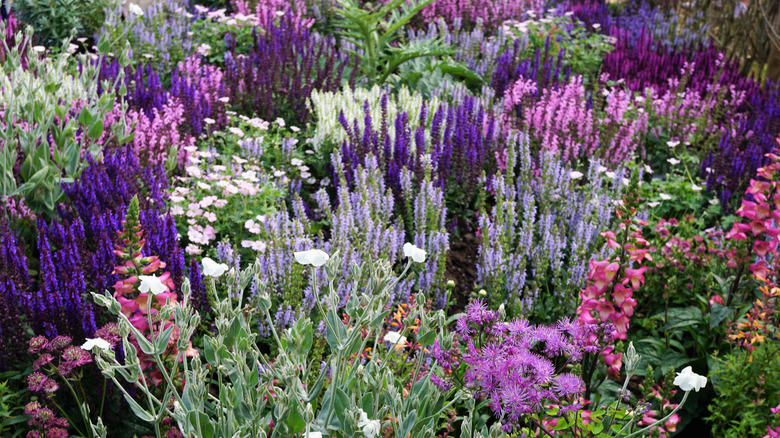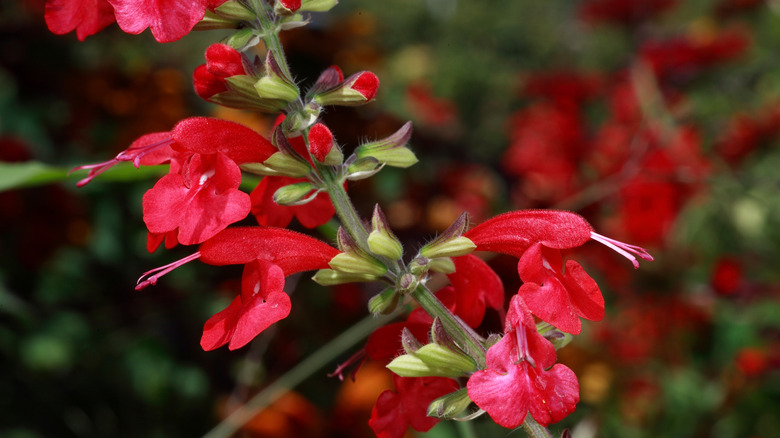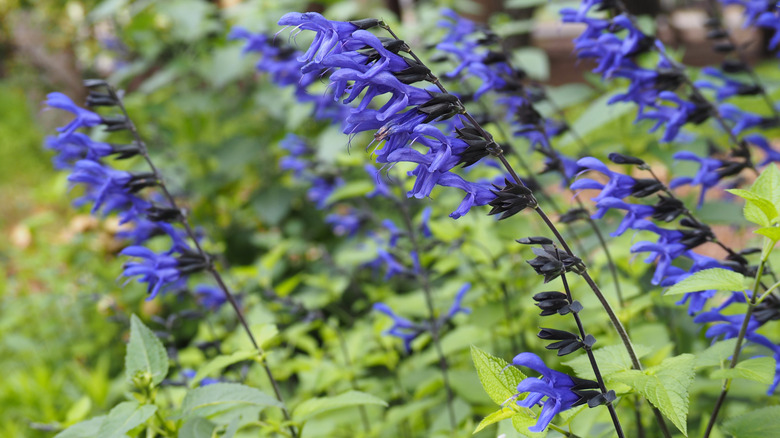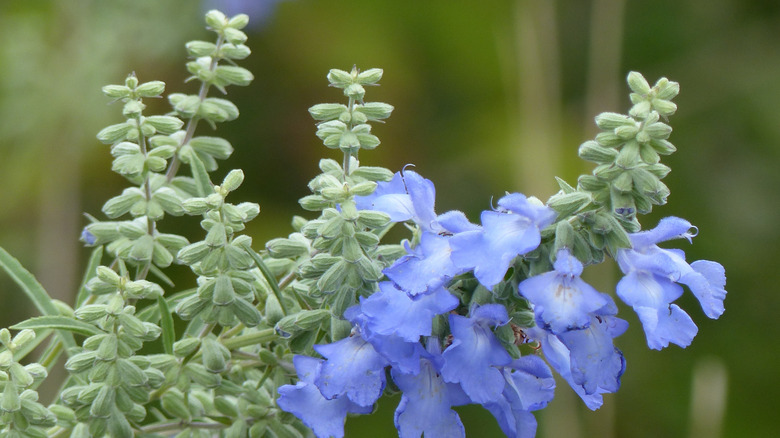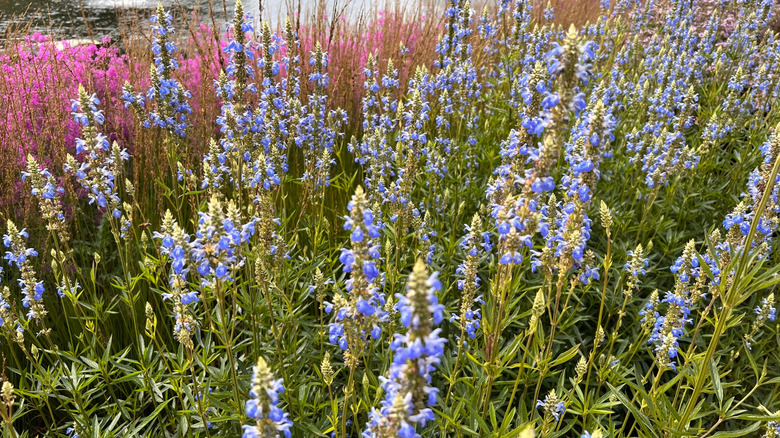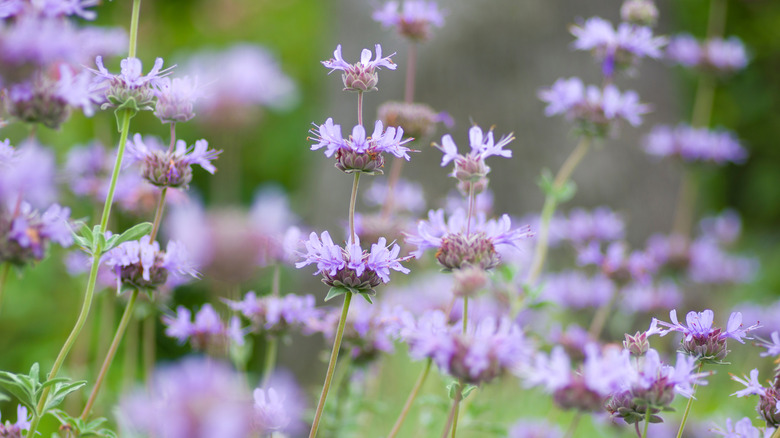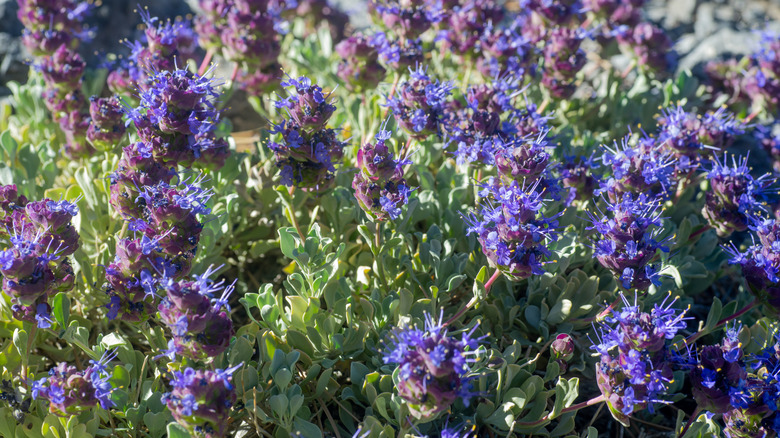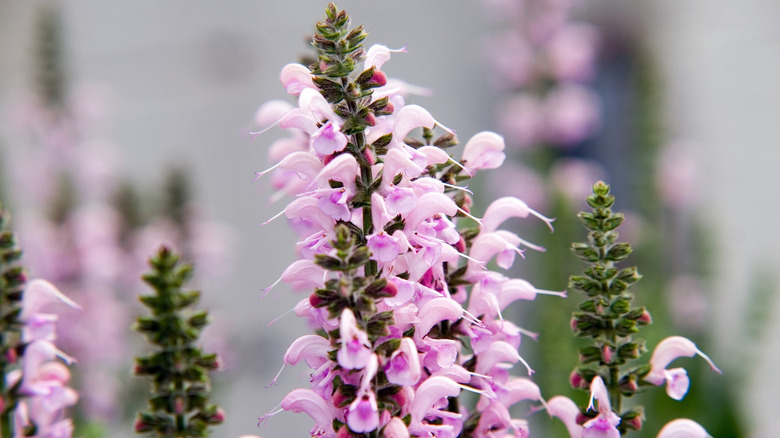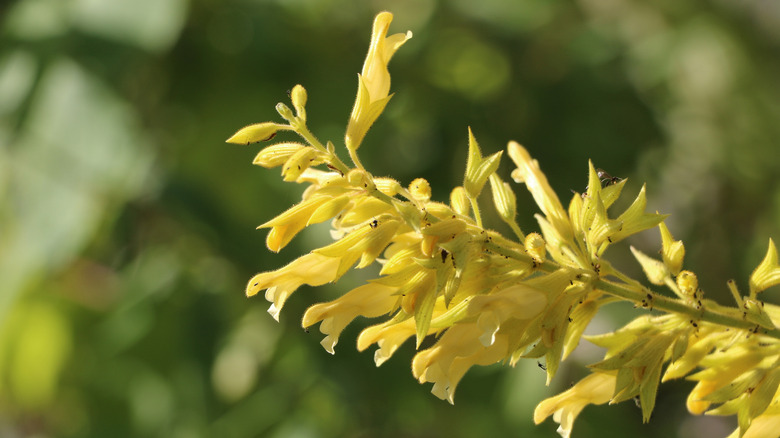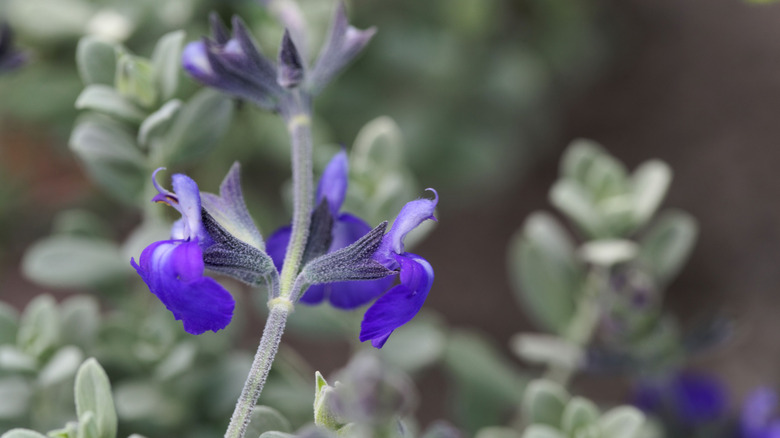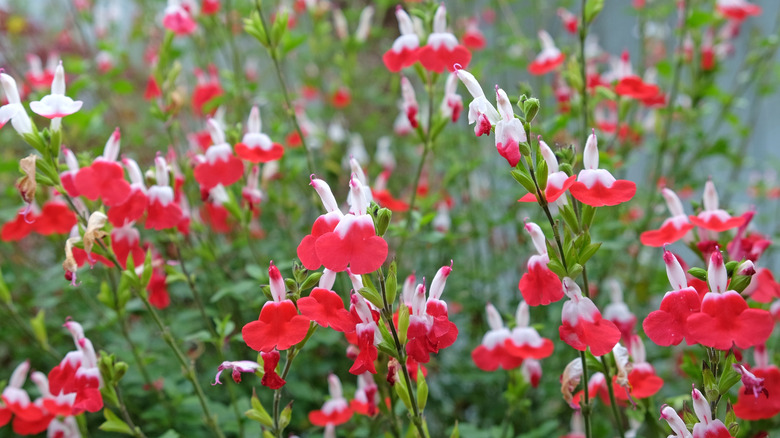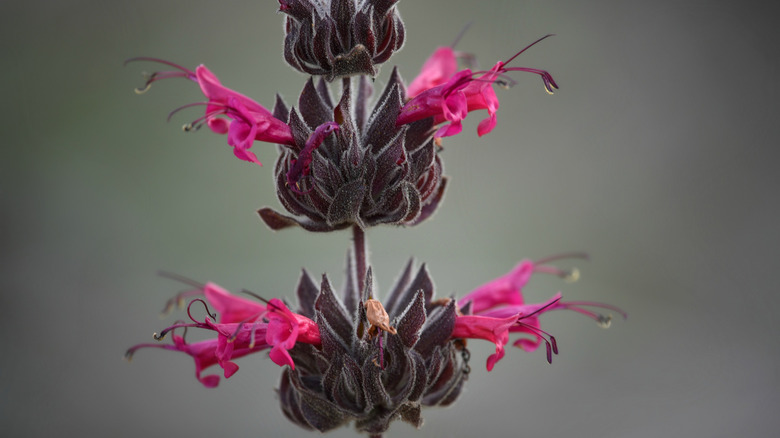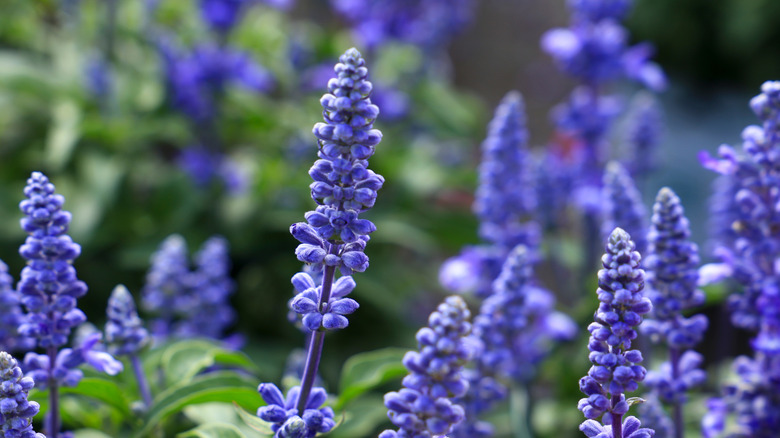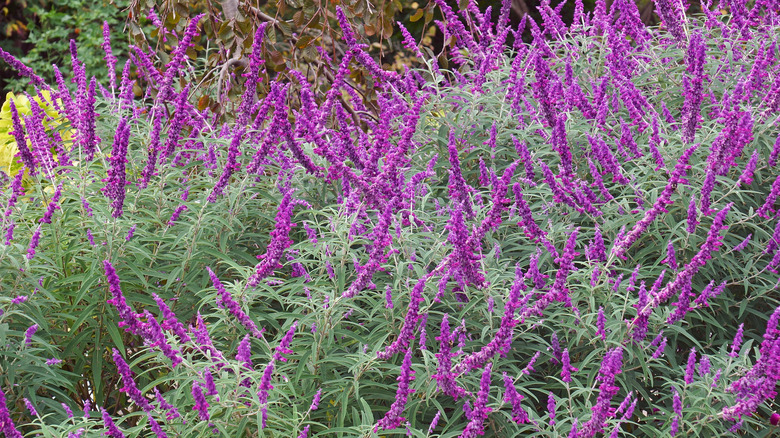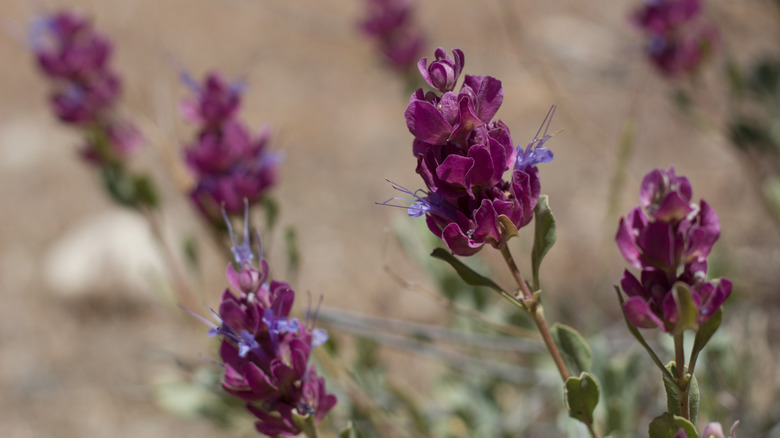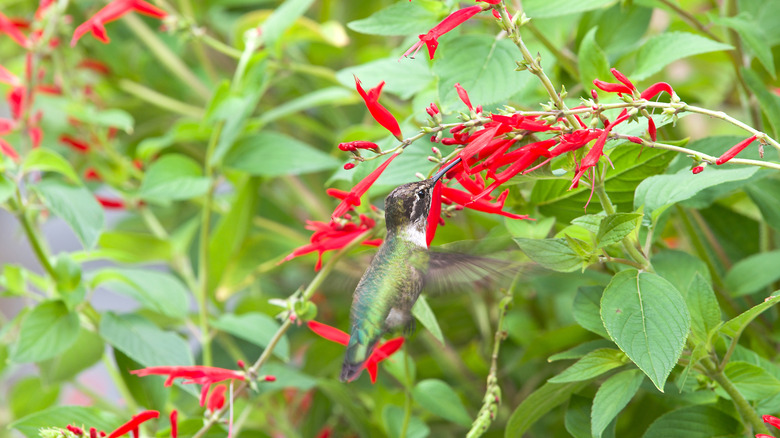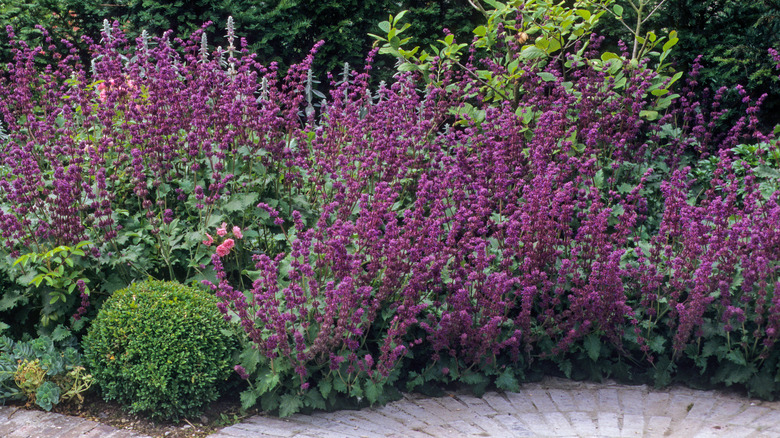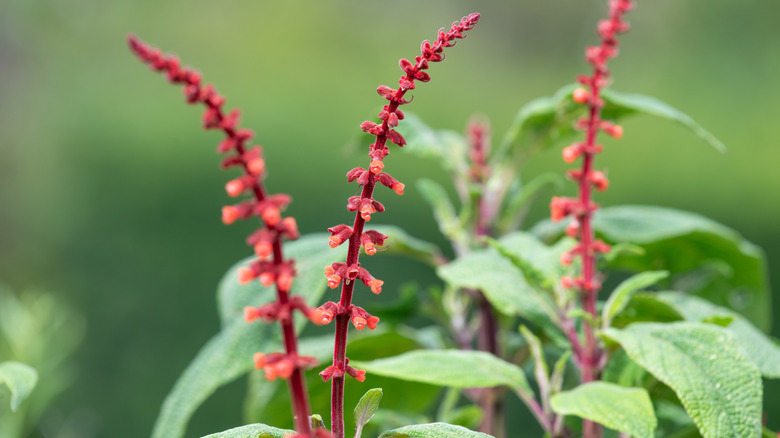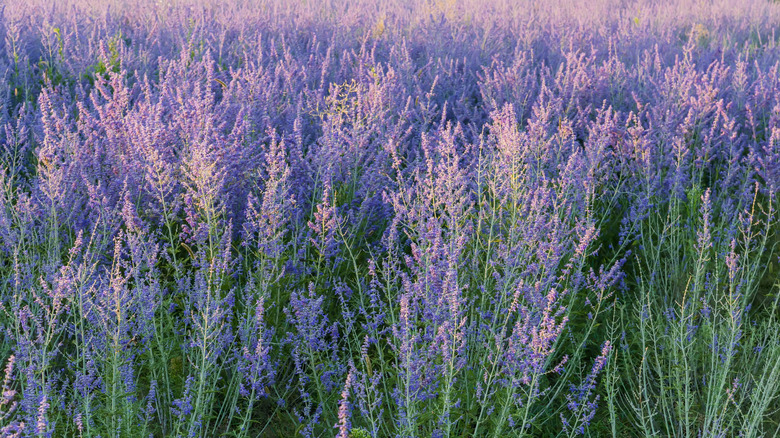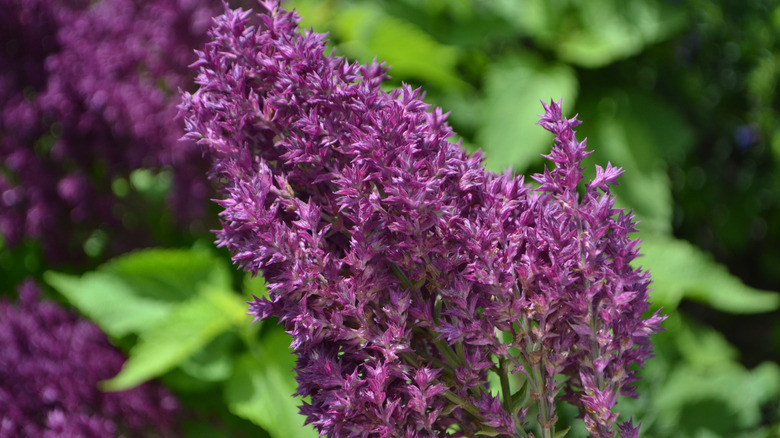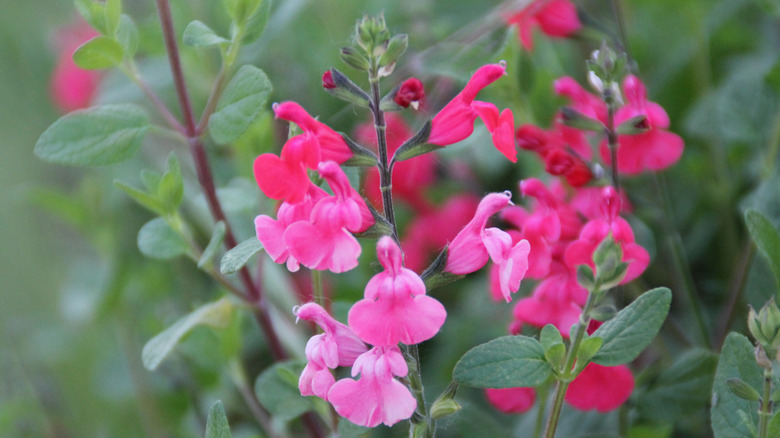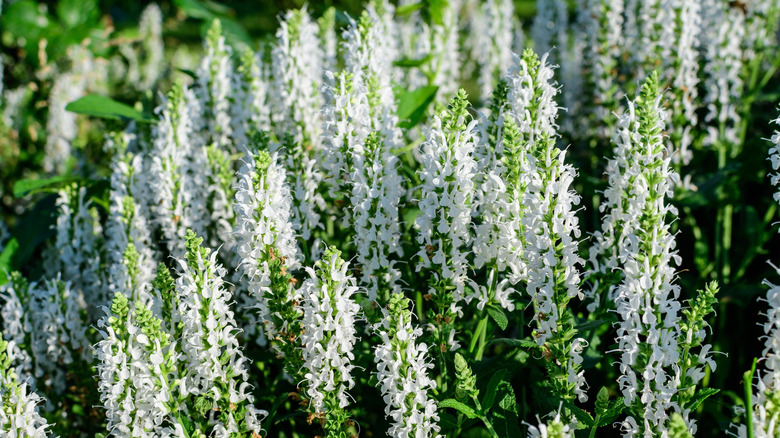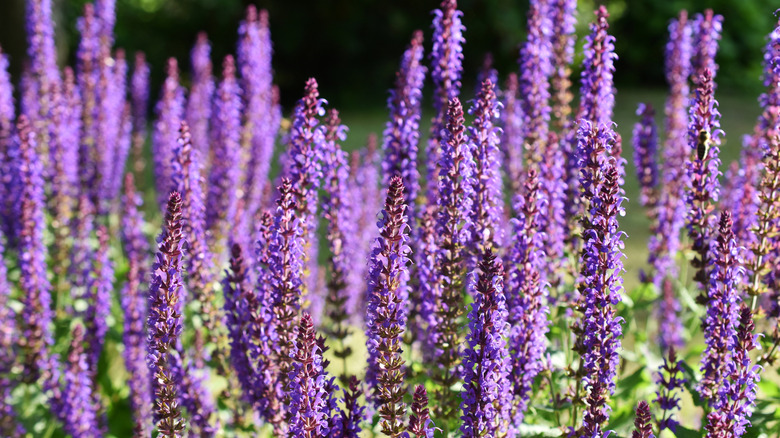24 Ornamental Sage Varieties To Consider For Your Space
Keeping your flower garden blooming from spring to fall can be a challenge, but when you add a combination of ornamental sage varieties to your flower beds, you can create color and texture in your landscaping that lasts the entire growing season. Ornamental sage plants (Salvia spp.), create eye-catching vertical or horizontal stretches of color, meanwhile attracting welcome pollinators, such as bees, butterflies, and hummingbirds, to the garden. Groupings of these gorgeous plants can be combined for a beautiful effect.
Known for their highly ornamental flower spikes, these deer-tolerant perennials come in a wide range of flower hues, foliage colors, and plant shapes. There are enough different types to grow a beguiling monochrome garden space, a pastel landscape, or a warm-hued flower patch — all in the same yard. Whatever your color palette, when choosing among the ornamental sages listed below be sure to select varieties that will survive winters in your USDA Hardiness Zone. Also compare the water needs of the plant against your own conditions because some prefer soil that is dry, while others require moist, wet, or moderately moist soil.
Baby sage
Baby sage is a plant that offers delicacy and softness. With flowers that are pink, red, burgundy, or white, baby sage (S. microphylla) is the perfect choice for adding beauty to butterfly gardens and mass plantings. Its lipped and tubular blooms are born from spring to autumn. Drought tolerant once established, baby sage can be chosen for soils with good drainage in USDA Hardiness zones 7 to 10.
Bloody sage
This next choice to consider is a bright bloomer that creates a fiery presence. The blooms of bloody sage (S. coccinea) are hummingbird magnets, and these tubular flowers can be burgundy, red, or pink, grow on a spike, and appear in summer. Also known as red or scarlet sage, this type of salvia excels in coastal areas, and is a great choice as an ornamental for growing next to walkways. Growing in evenly moist conditions with good drainage, this selection can be cultivated as a perennial in zones 8 to 10.
Blue anise sage
This next type of salvia brings a surprising color combination. Also known as Brazilian sage, blue anise sage (S. guaranitica) has fascinating flowers that are blue and black or blue and purple. Tubular, lipped flowers are held on spikes, attracting hummingbirds and butterflies all summer long. Gardeners in zones 7b to 10 can choose to grow blue anise sage as a perennial, keeping in mind this species prefers moist soil. A cultivar of this species, 'Black and Blue' is the beautiful deer-resistant blue flower that's perfect for your pollinator garden.
Blue sage
Next, consider blue sage, which provides a cooling presence with its silvery foliage. With delicately colored, blue blooms held on spikes, blue sage (S. azurea) is a plant that attracts bees and is excellent for meadows and small garden spaces. Also known as pitcher sage, this wildflower has tubular, lipped flowers that appear in summer and last through fall. This lovely type of salvia prefers moist growing conditions and is a perennial in zones 5 to 9.
Bog sage
Gardeners with wet soil can choose among ornamental sages as well, such as this plant. As its name would suggest, bog sage (S. uliginosa) is a wetland species that thrives in damp and poorly drained conditions. With eye-pleasing spikes of lipped, tubular blooms that are sky blue with white markings, this salvia can be used in rain gardens and cottage gardens, and will attract pollinators like bees. Bog sage is a perennial in zones 6 to 10, blooming in spring and summer.
Cedar sage
For red blooms that will grow in dappled shade, choose this next plant. Cedar sage (S. roemeriana) is a spring and summer bloomer that bears spikes of tubular, lipped flowers that are red to burgundy. Cedar sage needs good drainage and tolerates occasional dry conditions. These edible flowers grow best in part shade, doing well under cedar or juniper trees. Additionally, this beautiful salvia can be grown in fairy gardens or containers or used on slopes in zones 7 to 10.
Cleveland sage
Cleveland sage is an attractive plant with blooms that will remind some gardeners of bee balm. An evergreen shrub that is both aesthetically pleasing and very appealing to pollinators, Cleveland sage (S. clevelandii) bears whorls of lavender to violet colored, trumpet-shaped flowers from spring to fall. Available to gardeners in zones 7 to 10, this salvia requires dry soil conditions and is drought tolerant once established. As a bonus, the leaves of this flowering shrub can be used as a substitute for garden sage.
Desert sage
Gardeners growing ornamental gardens in desert locations will find attractive options for their consideration among the Salvia genus as well. An excellent choice for gardeners in arid locations, desert sage (S. dorrii) prospers in zones 5 to 9 and is adapted to dry soils once established. This small shrub provides silvery, evergreen to semi-evergreen foliage. In winter, spring, and summer, desert sage produces blooms that grow in clusters and are blue to purple to mauve. Butterflies and bees love these plants, which can be grown in wildlife-friendly xeriscapes.
'Eveline'
Fans of soft pink flowers may consider this plant selection a new favorite. 'Eveline' is a hybrid sage cultivar which bears showy, delicately colored, pink and purple blooms early in the season, from spring to early summer. This ornamental salvia can be grown in zones 4 to 8, in soils that are dry to average in moisture content. Gardeners will enjoy the smell of this deer-tolerant sage's fragrant leaves in their spaces, while butterflies appreciate nectar from the flowers of 'Eveline'.
Forsythia sage
Yellow flowers abound among wildflower options, and there's even a yellow Salvia that will grab ornamental gardeners' eyes. With cheery, tubular, yellow flowers held on long spikes, forsythia sage (S. madrensis) is loved by hummingbirds, butterflies, and bees. This semi-evergreen plant bears its sunny blooms in fall and winter. Gardeners in zones 7 to 11 can choose forsythia sage for well-draining, moist soils.
Germander sage
Fans of gray and silvery colored plants will find this Salvia species a perfect choice for their ornamental growing space. Producing spikes of bright blue flowers, germander sage (S. chamaedryoides) blooms from early summer to early autumn, and this plant can be used to attract hummingbirds and other pollinators in xeriscapes. Gardeners in zones 7 to 10 will want to grow this small, evergreen to semi-evergreen shrub in dry soil that has good drainage.
'Hot lips'
For ornamental gardeners who like to choose plants which cannot be ignored, 'Hot Lips' might become a new favorite. A cultivar of baby sage (S. microphylla), 'Hot Lips' is one of the top salvia picks for stunning container gardens. With flowers that are white with red lower lips, 'Hot Lips' sage is both edible and excels at feeding pollinators such as bees and butterflies. Gardeners in zones 7 to 10 can grow heat tolerant 'Hot Lips' in well drained soil. Expect blooms from spring through fall.
Hummingbird sage
To add a surprising antique look to the ornamental garden, some gardeners may consider growing the dark purple bracts of hummingbird sage. With flower spikes sporting whorls of magenta blooms, hummingbird sage (Salvia spathacea) is an evergreen plant that prefers dry soil and somewhat shady conditions. A favorite of hummingbirds and bats, this salvia flowers from late winter to summer, and can be grown in zones 8 to 10.
Mealycup sage
With dense bloom spikes, this plant brings texture and color to flower gardens and borders. Blooming from spring to fall, mealycup sage (S. farinacea) bears fuzzy flower spikes of fragrant, blue or purple flowers marked with white. Also known as blue, mealy blue, or mealy sage, this salvia is a beautiful sage variety you'll want to add to your garden. This ornamental species looks perfect in cottage gardens or flower borders, and is a favorite of birds and pollinators. It can be grown as a perennial in zones 8 to 10, and prefers moist conditions and soil that drains well.
Mexican bush sage
Gardeners in search of big visual texture might choose this next type of salvia. A fall bloomer, Mexican bush sage (S. leucantha) produces long spikes of purple and white flowers favored by hummingbirds and other pollinators. While its aesthetic features may inspire gardeners to include it in decorative borders, this rabbit-resistant ornamental plant can also be grown in sloping yards. Grow Mexican bush sage in moist soils in zones 7 to 10.
Mojave sage
Gardeners in arid locations have multiple choices to consider for colorful plants, including this Salvia species. Mojave sage (S. pachyphylla) is the gorgeous and underrated type of sage that adds a pop of pink to your garden. This ornamental and drought tolerant plant bears flowers throughout the summer. These blooms are pink and bluish-purple, growing along the flower stalk in thick clusters, above fragrant, silver, evergreen foliage. Adapted to arid locations, this salvia attracts pollinators and thrives in xeriscapes in zones 5 to 10.
Pineapple sage
No one said ornamental plants couldn't also be wildly popular with hummingbirds. Pineapple sage (S. elegans) adds both beauty and fragrance to flower beds, blooming from summer through fall. With tubular red flowers, pineapple sage helps you easily attract hummingbirds to a garden with an herb that smells as sweet as it sounds. This sage is perennial in zones 8 to 10, and grown as an annual in areas with colder winters, but make sure to keep the soil in the growing space moist. As a delicious bonus, the fragrant blooms and foliage of this salvia can be used to make herbal teas.
'Purple Rain'
You'd be forgiven if masses of purple blooms led you to think of the musical genius, Prince — and you wouldn't be the only one. For arching spires of purple flowers, plant 'Purple Rain' in your ornamental garden beds. This cultivar of S. verticillata is compact, with blooms appearing from summer to fall. In addition to adding drama to your garden, 'Purple Rain' will attract butterflies and resist deer. Perennial in zones 5 to 8, 'Purple Rain' grows well in soils which are dry or have a medium moisture content.
Red velvet sage
Texture in the flower garden sometimes appears in small details, such as a velvety touch. With velvety, red flower spikes dotted with orange blooms, red velvet sage (S. confertiflora) is a giant among ornamental sages, reaching 6 feet tall or more, and flowering in autumn. This is a type of salvia you can grow in part shade, as long as you can provide moderately moist growing conditions. This evergreen plant isn't very frost hardy, only tolerating low temperatures between 25 or 30 degrees Fahrenheit. Gardeners in zones 9 to 11 can grow this beautiful species as a perennial.
Russian sage
While many ornamental sages provide interest with their distinctive blooms, some species are more eye-catching when grown in large groups, such as this Salvia species. If you want to plant one drought and heat tolerant plant for lavender blue blooms through fall, choose Russian sage (S. yangii). With airy flower stalks that create a haze of color, this type of salvia excels at looking gorgeous when grown in dry soils. Russian sage is a fragrant, pollution-tolerant perennial which can be grown in zones 5 to 9.
'Schwellenburg'
Your garden visitors will be surprised to learn that this plumed plant is a salvia. A cultivar of S. nemorosa, 'Schwellenburg' sage bears showy, reddish purple flower spikes which have a feathery appearance that continues from late spring to fall if plants are deadheaded. A favorite of butterflies, this attractive salvia has aromatic foliage, and can be included in garden spaces in zones 4 to 8, in dry to moderately moist soils.
Texas sage
Hot pink isn't just a hue found among cultivated species — this coloring can be found among native Salvia species as well. With wide-lipped, pink, red, white, or burgundy flowers, Texas sage (S. greggii) is a semi-evergreen ornamental sage that bees and hummingbirds love. Also known as red Chihuahuan or autumn sage, this plant produces its brilliant blooms from spring to autumn. Gardeners in zones 6 to 9 can choose this drought-tolerant plant for a perennial to grow in well-draining soils.
'White profusion'
For gardeners seeking to cultivate calm in the garden, this white variety brings beauty as well as peacefulness. Gardeners looking for a white option to grow in their ornamental sage collection can turn to the beautiful 'White Profusion', a cultivar of S. nemorosa. With 'White Profusion', spikes of fragrant, white flowers rise over compact plants that bloom from late spring to fall. Hummingbirds love this attractive sage, which can grow in dry to moderately moist soils in zones 4 to 8.
Woodland sage
Gardeners looking for a striking ornamental sage for their cottage gardens might choose woodland sage (S. nemorosa). While there are numerous cultivars of this fragrant plant, also known as Balkan clary or violet sage, the straight species is highly attractive and well-worth including in a flower bed. Woodland sage bears spikes of violet and reddish purple flowers that attract pollinators such as bees. This low-maintenance plant grows beautifully in soils which are moist to occasionally dry, in zones 4 to 8. Expect blooms from early summer to early autumn.
